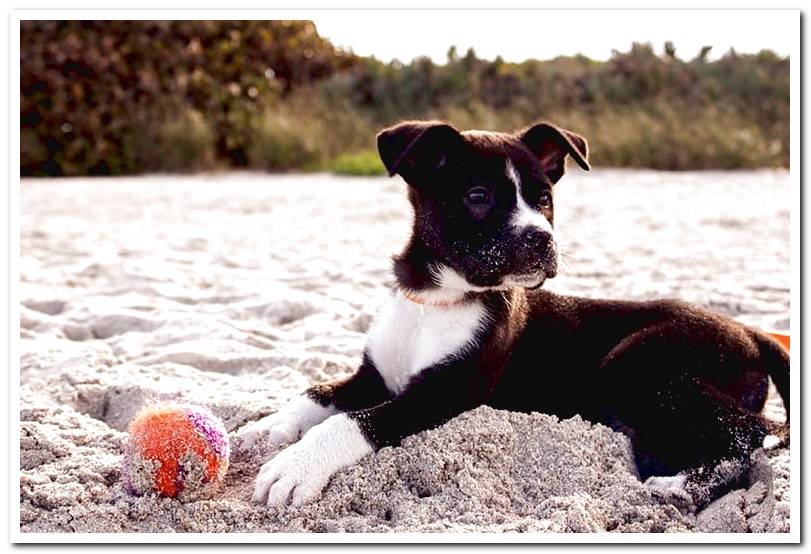
Fortunately, dogs increasingly have easier access to Spanish beaches. However, once there, not everything is fun, but you have to take many precautions while our friend enjoys this natural environment.
Like humans, dogs can also be victims of jellyfish stings, one of the most frequent dangers on beaches. So from I’m a dog We want to explain what to do if your dog is stung by a jellyfish. You must act fast!
- You may also like: Spanish beaches that allow dogs in summer
Index of contents
- 1 Jellyfish types and danger
- 2 Factors that aggravate the jellyfish sting in dogs
- 3 Symptoms of a jellyfish sting in dogs
- 4 My dog has been stung by a jellyfish. What should I do?
Jellyfish types and danger
Jellyfish are animals from the group of cnidarians with stinging cells called nematocytes. These cells are made up of venom transmitted through stingers or darts when they come into contact with the skin of another animal.
There are between 350 and 500 species of jellyfish in the world. Some of the most frequently found on the Spanish coasts are:
- The common jellyfish or umbrella (Aurelia aurita): It has a transparent color stained with blue and white colors and short tentacles. This species is not very abundant, it is usually found in coastal areas such as the Mar Menor. Its dangerousness is very low.
- Curd water (Cotylorhiza tuberculata): It is yellowish brown in color, shaped like an umbrella and about 20 cm in diameter. It is frequent to find it in Mediterranean waters. Its dangerousness is low.
- The blue acalefo (Rhizostoma pulmo): It stands out for its white and blue colors and its about 90 cm diameter. It is a typical species of the Atlantic and the Mediterranean. Its dangerousness is medium.
- The radiated acalefo (Chrysaora hysoscella): It is yellowish white in color and measures about 30 cm in diameter. It can be seen in Atlantic and Mediterranean waters. Its dangerousness is high.
- The luminescent jellyfish (Pelagia noctiluca): It is reddish pink in color, has long tentacles and is about 20 cm in diameter. It abounds in both the Atlantic Ocean and the Mediterranean Sea. Its dangerousness is high.
- The Portuguese caravel (Physalia physalis): in fact this animal is not a jellyfish, but a hydrozoan made up of polyps. It is about 30 cm long and 10 cm wide. It can be seen in temperate waters of the Atlantic and in the Mediterranean. Its dangerousness is very high.

Factors that aggravate the jellyfish sting in dogs
Given their curiosity and willingness to play, dogs are easy targets for jellyfish stings. When this happens, the dogs feel the same pain that we do, but they can also be added other factors that exacerbate the consequences :
- Jellyfish species: it is not the same thing that a common jellyfish stings you as a radiated head, for example. So, if we have seen the jellyfish that has stung you, we should describe it to the vet who will take care of our puppy.
- Dog Health: A vital factor in this regard is the state of health that our friend presents. A weakened immune system can further aggravate the situation.
- Dog’s age: older puppies and dogs are more sensitive to the effects of bites.
- Dog Weight: if we talk about a dog of no more than three or four kilos with a sting of considerable size, the symptoms and consequences will be more serious than a bite with the same amount of venom in a large dog.
- Surface affected by the bite: This will depend on where the bite is located and the thickness of the skin on it. For example, abdomen, truffle, inner face of the ears, oral cavity or inguinal regions are more sensitive areas given the lack of a protective layer of abundant hair.
- Amount of poison injected: Obviously, if the bite is minor, it will have a much better solution than a large bite, with a lot of venom injected and affecting several areas.

Symptoms of a jellyfish sting in dogs
Some of the symptoms that can alert us that our dog has been stung by a jellyfish are:
- Pain
- Stinging
- Crying
- Skin wounds
- Edema (swelling caused by the accumulation of fluids on the skin)
- Erythema (redness of the skin)
- Purito (itching)
- Presence of papules
- Agitation
- Muscle cramps
In severe cases:
- Fatigue
- Nausea and vomiting
- Dyspnea (respiratory distress)
- Syncope

My dog has been stung by a jellyfish. What should I do?
If this incident unfortunately ruins your beach day, lor ideally, you should go to the vet as soon as possible, especially if the dog presents any of the factors already mentioned that increase the risk of serious consequences, including death.
If, on the other hand, it is impossible for you to go to the vet at that precise moment, then we leave you a list
of the steps you must follow to treat a jellyfish sting in dogs. The speed with which you act is vital for the subsequent recovery of the dog.
Mind you, jellyfish stings are serious injuries to the dogs that must be treated urgently by the vet Therefore, following these steps is not a substitute for the obligatory visit to the specialist, they will only allow us to save time and calm the pain a little.
Steps to follow:
- First, remove the dog from the area where the jellyfish is located and avoid as much as possible that your friend scratches or licks the area, as this can cause the venom to spread.
- You should apply ice for 10 or 15 minutes to reduce pain in the affected area, since the cold offers a “local anesthesia” effect. You should never apply the cold directly to the skin, wrap the ice in a towel or bag.
- Inspect the area for tentacles or other remains of the jellyfish. If you appreciate something, you must remove it with great care, with tweezers or gloves, to avoid it affecting you, and rinse the area with plenty of salt water.
- Wash the lesion with 5-10% acetic acid (vinegar) for about 15 minutes to avoid discharge of nematocysts. Skip this step in the case of a Portuguese caravel sting.
- Next, dry the skin gently and without rubbing and apply an analgesic ointment, such as lidocaine or benzocaine, with corticosteroids or antihistamines to help alleviate the allergic reaction.
- Go to the vet as soon as possible.
The normal thing is that the symptoms disappear in a few days, although secondary complications such as infections can occur, so we must monitor the affected area and communicate to the veterinaryn any changes that we appreciate both physically and behaviorally.
Finally, we must not forget that, despite the danger, the beach is a fantastic place to have a great time with your best friend with four legs. So, if you are careful and pay attention to the dog, you can both spend a summer day with many benefits.
